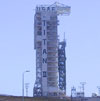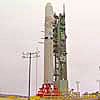|
Sunday:
January 21, 2001 | |
0245 GMT |
 |
Titan 2 rocket set for another launch try Sunday
The U.S. Air Force is prepaing to make a second attempt to launch a military weather satellite aboard a converted Titan 2 rocket booster from Vandenberg Air Force Base in California. Liftoff is set for 1358 GMT (8:58 a.m. EST) Sunday, one day after faulty ground equipment caused a spacecraft commanding problem and aborted countdown.
 MISSION STATUS CENTER - updates MISSION STATUS CENTER - updates
 |  |

|
 |
First photos released from new Earth imaging satellite
A commercial satellite launched last month to snap high-resolution images of Earth has beamed back a sample of its picture-taking ability, including views of France, Turkey, Cyprus and South Korea.
 FULL STORY FULL STORY
 |  |

|
 |
DAILY BRIEFING Other stories making news today
|
 |
Public can again request shuttle launch passes -- Written requests for vehicle passes to view Space Shuttle launches within the restricted perimeter of Kennedy Space Center are once again being accepted. These passes grant visitors permission to drive through several designated guard stations to a public viewing site on the causeway between KSC and Cape Canaveral.

Studying Earth from space shows rainfall extremes -- Researchers at NASA and the University of Maryland studying changes in tropical precipitation patterns, have noted a higher frequency of El Ninos and La Ninas over the last 21 years.
|
 |
|
Saturday:
January 20, 2001 | |
0220 GMT |
 |
Titan 2 rocket poised to launch weather satellite
The final hours of the countdown are underway at Vandenberg Air Force Base in California as a U.S. military weather satellite nears liftoff just before dawn Saturday aboard a refurbished Titan 2 rocket booster.
 MISSION STATUS CENTER MISSION STATUS CENTER
 LAUNCH PREVIEW STORY LAUNCH PREVIEW STORY
 |  |

|
 |
Russians set new launch date for Mir's deorbiting tug
RKK Energia officials currently plan to make another attempt to launch the Progress M1-5 cargo ship toward Mir on January 24, if mission controllers in Korolev can reboot the main computer onboard the station in time.
 FULL STORY FULL STORY
 EARLIER LAUNCH DELAY STORY EARLIER LAUNCH DELAY STORY
 |  |

|
 |
Shuttle rolls off pad
Space shuttle Atlantis made a six-hour trek from launch pad 39A to Kennedy Space Center's 52-story Vehicle Assembly Building on Friday. The rollback was ordered so workers can inspect solid rocket booster cabling. Atlantis' launch has been postponed until at least February 6.
 MISSION STATUS CENTER MISSION STATUS CENTER
 |  |

|
 |
International team building next explorer to study Sun
Our Sun is a violent star and is capable of producing explosive flares and hurling clouds of matter toward Earth -- activities that in the past have interfered with satellite communications and electric power transmission grids on Earth. To learn more, scientists from Japan, the U.S. and U.K. are working together to a new solar satellite.
 FULL STORY FULL STORY
 |  |

|
 |
|
Friday:
January 19, 2001 | |
0344 GMT |
 |
Remarkable new views captured of Orion Nebula
Orion the Hunter is perhaps the best known constellation in the sky, well placed in the evening at this time of the year for observers in both the northern and southern hemispheres, and instantly recognizable. The new pictures captured by astronomers are a must see!
 FULL STORY FULL STORY
 |  |

|
 |
Nuclear engine promises to slash travel times to Mars
A novel type of nuclear reactor could cut make it possible for spacecraft to travel from the Earth to Mars in as little as two weeks, one Israeli researcher has found. A little-known isotope of an artificially produced element could power future robotic or human spacecraft far more efficiently than chemical or other nuclear propulsion sources.
 FULL STORY FULL STORY
 |  |

|
 |
Space station crew faces tough schedule
An 18-day delay for the next space station assembly mission has thrown a wrench into the on-board crew's timeline, compressing an already busy schedule of work that must be completed before arrival of their replacements in early March, officials said Thursday.
 FULL STORY FULL STORY
 |  |

|
 |
Titan rocket to launch weather satellite Saturday
The 26-hour countdown is scheduled to begin this morning at Vandenberg Air Force Base in California leading to Saturday's launch of a U.S. military weather satellite aboard a refurbished Titan 2 rocket booster.
 MISSION STATUS CENTER MISSION STATUS CENTER
 LAUNCH PREVIEW STORY LAUNCH PREVIEW STORY
 |  |

|
 |
Stardust looks down on Moon's north pole
Just after NASA's Stardust spacecraft successfully flew by the Earth on Monday to use the planet's gravity to change its orbit, the comet-bound probe took a series of images of the Moon to calibrate its onboard camera.
 FULL STORY FULL STORY
 |  |

|
 |
Leonids rose to occasion, despite bad weather
Read about the adventures and results of European astronomers as they attempted to image the Leonids meteors by splitting up into teams and working from different locations to create stereo observations.
 FULL STORY FULL STORY
 |  |

|
 |
DAILY BRIEFING Other stories making news today
|
 |
Cassini space probe journeys into Jupiter's magnetosphere -- Data from NASA's Cassini spacecraft shows that the craft recent was inside Jupiter's magnetosphere at the same time the Galileo probe flew within the vast surrounding environment of charged particles moving under the influence of the planet's magnetic field. This marks the first time humankind has placed two spacecraft within the magnetosphere of an outer planet at the same time.
|
 |
|
Thursday:
January 18, 2001 | |
0659 GMT |
 |
Launch of Progress freighter to Mir scrubbed
Orientation troubles aboard the abandoned Russian space station Mir forced officials to scrub today's planned launch of an unmanned freighter that will ultimately deorbit the outpost in March.
 FULL STORY FULL STORY
 |  |

|
 |
Ice may have formed Martian channels
Some channels on the surface of Mars believed to have been formed by running water may have instead been carved by streams of ice. Channels in one region of Mars share a number of key characteristics with those created by ice streams that flow beneath Antarctica's surface and empty into the surrounding oceans.
 FULL STORY FULL STORY
 |  |

|
 |
U.S. weather satellite launch bumped to Saturday
A vintage Titan 2 rocket built in the 1960s is poised for a $430 million launch before sunrise Saturday from Central California carrying a crucial replacement global weather satellite for the U.S. military. The liftoff was delayed 24 hours so workers could replace a faulty cabling used in pre-flight rocket testing.
 FULL STORY FULL STORY
 |  |

|
 |
Cassini probe fails to find lightning on Venus
Space physicist Donald Gurnett says that a search for lightning on Venus in 1998 and 1999 using the Cassini spacecraft failed to detect high-frequency radio waves commonly associated with lightning. The possible existence of lightning at Venus has long been controversial.
 FULL STORY FULL STORY
 |  |

|
 |
DAILY BRIEFING Other stories making news today
|
 |
Globalstar acts to assure funds for further operations -- Globalstar has announced that, in order to have sufficient funds available for the continued progress of its marketing and service activities, it has suspended indefinitely principal and interest payments on all of its funded debt and dividend payments on its preferred stock.

Experimental European satellite switches rockets -- Europe has officially dropped a previous agreement with Japan to launch the Artemis experimental communications satellite aboard the unproven H-2A rocket in favor of using an Ariane 5 booster.
|
 |
|
Wednesday:
January 17, 2001 | |
0320 GMT |
 |
NASA's shuttle chief defends rollback decision
Launch of the next space shuttle mission has been delayed from Friday to no earlier than Feb. 6. NASA's shuttle program manager said in the end, the launch team had little choice after problems surfaced with wiring. "I guard against the phenomena of 'go fever' like it was the plague. And you have to be very sensitive as you get closer to launch."
 FULL STORY FULL STORY
 AUDIO: SHEPHERD REACTS TO DELAY (70k file) AUDIO: SHEPHERD REACTS TO DELAY (70k file)
 |  |

|
 |
China's Shenzhou 2 capsule returns to Earth safely
The Shenzhou 2 spacecraft returned safely to Earth Tuesday, touching down in China's inner Mongolian region at 1122 GMT after making 108 orbits. The mission paves the way for a future manned mission by the Chinese.
 FULL STORY FULL STORY
 |  |

|
 |
Individual stars spotted in Andromeda's bulge
An individual team, including an astronomer of Observatoire de Paris, has recently observed for the first time individual stars in a very dense -- but very interesting -- zone of an external galaxy, enabling for the first time an eagerly awaited comparison with the corresponding zone (bulge) of our Milky Way galaxy.
 FULL STORY FULL STORY
 |  |

|
 |
Space tug poised for launch to Russia's Mir station
The Progress M1-5 cargo ship, the last spacecraft to visit Russian Mir space station, rolled out to the launch pad at the Baikonur Cosmodrome on Tuesday. Blastoff is scheduled for Thursday.
 FULL STORY FULL STORY
 |  |

|
 |
NASA opens 2nd generation reusable rocket program
NASA has created a new program office to lead its effort to enable
development of a new reusable launch vehicle for flight in 2010 that will be
dramatically safer and less expensive than today's rockets.
 FULL STORY FULL STORY
 |  |

|
 |
DAILY BRIEFING Other stories making news today
|
 |
The Eastern U.S. keeps its cool while the world warms -- Much of the Earth has warmed over the last half-century, but the eastern half of the United States has shown a cooling trend. NASA-funded research indicates cooler temperatures in the eastern U.S. are caused by an increase in sun-shielding clouds produced by warmer ocean temperatures in the Pacific.
|
 |
|
Tuesday:
January 16, 2001 | |
0439 GMT |
 |
Wiring checks delay shuttle Atlantis launch to February
On the eve of shuttle Atlantis' countdown to launch Friday, NASA managers on Monday instead ordered engineers to haul the spacecraft back to the Vehicle Assembly Building for work to test suspect wiring in the ship's booster separation system.
 FULL STORY FULL STORY
 MISSION STATUS CENTER MISSION STATUS CENTER
 |  |

|


 The Hubble Space Telescope's majestic view of the Eskimo Nebula. This spectacular poster is available now from the Astronomy Now Store.
The Hubble Space Telescope's majestic view of the Eskimo Nebula. This spectacular poster is available now from the Astronomy Now Store.